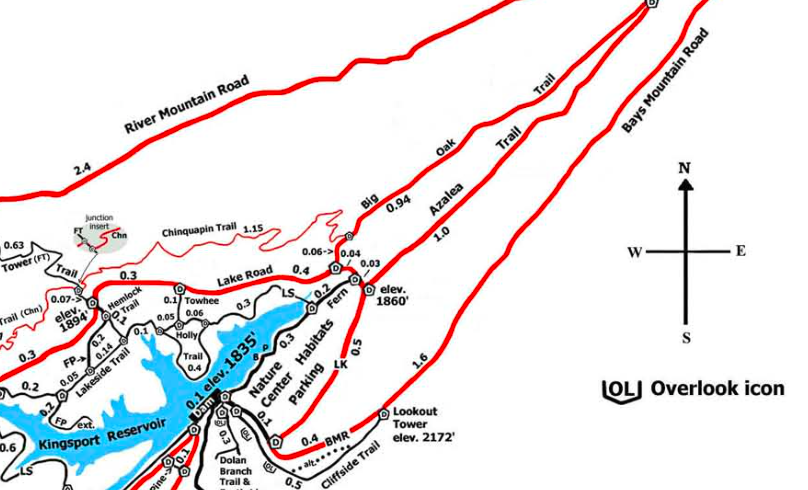Jogging Writer: 10K Follow Up & Facts
 |
| Here’s a partial map of Bays Mountain Park’s 39 miles of trails. The 10K included trails like Fern, Lake, Chinquapin, and Big Oak, among others. |
Apparently, in the trail world of racing, distances are estimates. This is for the obvious reason that if a race course organizer needs to end a race a 6.2 miles but there simply aren’t any trails that lead to an efficient finish line in the distance needed, the organizer can’t exactly build a new trail. For this reason, the owner of Kingsport’s Fleet Feet (and sponsor of the Rocky Top XTERRA 10K last week) explained to me, racing distances for single track trail races are close estimates. He also reminded me that because no two trail races are alike in tread conditions, grade, and elevation, it’s not a good idea to compare a PR (personal record) time on one course with any times from another course. In the same way, races run on pavement–which can be exact, and in the racing world are completely expected to be exact–should never be compared to a race of the same distance on single track trail.
“I’m hosting a 50K in April,” the Fleet Feet guy told me. “That’s 32 miles. The course I’ve charted is actually 36.4 miles…but it’s still billed as a 50K, it’s still scored as a 50K, and that’s the working understanding every runner who signs up will have.”
He went on to tell me that the 10K I ran at Bays Mountain wasn’t 6.2 miles, but 6.8 miles. I did a little math, figured out what my time would have been without that extra 6/10 of a mile, and further divided that by the number of miles in a proper 10K. What did I learn? That I ran almost exactly 1 minute per mile slower on race day than my personal record (also partially on single-track trail). That’s a pretty safe and smart slow-down decision, if you consider the rainy and slick conditions that day.
All of that said, I logically concur that a race time for 6.2 miles on one trail shouldn’t be compared with a race time for 6.2 miles on a different trail, but part me feels like getting roughly the same race time on either course is the point of training. After all, we train so we can consistently perform at our best, right? Same with my novel. Whether I’m writing with conditions of silence, solitude, and home baked lasagna or I’m writing in a crowded, loud, overstuffed Starbucks with burnt drip coffee…my sentences still have to pull their weight and achieve the same, desired impact in the end.
The point of all this exploration? Learning. Plus, I feel better. It’s not that I felt horrible about my race time (I did finish, after all, and had more steam to keep going). But I did feel disoriented. Now I know why.
I also know that what’s been missing from my training is one run a week where I run at my own preferred pace, slowed down about half a notch. I’ve been so strict about following Matt Fitzgerald’s 80/20 running plan (which I highly recommend) that over-focusing on pacing, heart rate, and endurance cost me a little in intuition and personal accommodations. I’m one week into my Half Marathon training and every Sunday between now and March 28th will be my “long run” for the week. Unlike the other runs–which aren’t given a distance limit, rather, just a certain number of minutes per heart rate zone–the long runs have time, zone, and distance limits. But the way Fitzgerald outlines the workout, there’s no way I can stay in the heart rate zones he recommends and run the full distance in the time allotted. I simply have to run faster to get the job done, which is something I’ve been wanting to do all along. Today I ran 7 miles and it felt great. I’m ready for more.

